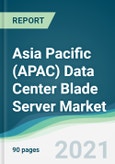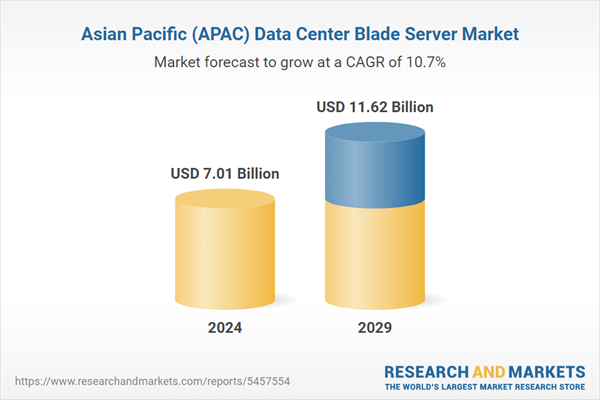A Blade server is a portable device that distributes and manages data in a network. This device serves as an interface between computers, programs, applications, and systems. Essentially, a blade server is a modularly designed server computer optimized for using a minimum amount of physical space and energy. Most often, these are used by large data centers because they need to maximize their space and power capacity utilization and efficiency, have high computing requirements, and can support a higher thermal and electrical load.
Corporate culture in major APAC economies is on the rise, increasing the organization’s overall data volume, thereby propelling the requirement for modern infrastructure to backup data storage. Hence, several countries, including India, Japan, and China, are becoming more attractive data center destinations, given their extensive investments in telecommunications, banking, and insurance, among other sectors requiring new data centers. Booming cloud computing in the region has also propelled the demand for blade servers, bolstering market expansion.
Asia Pacific (APAC) Data Center Blade Server Market Drivers
Growing adoption in the utility and energy sectors has propelled the market growth.
The adaptation of digitalization in the energy and utility sector is driving a requirement for data accumulation and an increase in the costs associated with power consumption, which fuel the market. Recently, Google's 9,500-kilometer fiber-optic submarine cable project connecting Japan, Guam, and Australia will have 36 Tbps of capacity. Renewable power is expected to contribute 24% of the country's electricity by 2030. Renewable energy production from solar power plants has increased. Cloud computing is used in the energy sector to boost manageability and improve business decisions, requiring data centers.The growth of cloud services is expected to drive the market growth.
AI technology is aggressively being pursued by major Korean ICT companies. Among the leading electronics companies - Samsung and LG Electronics - the top internet companies - Kakao and Naver, and the major telecom companies - SK and KT - have invested significantly in artificial intelligence.Through the development and acquisition of data centers and other facilities, Mitsui & Co. is expected to invest 300 billion yen by 2026 which involved building three large data center buildings in Kyoto and Chiba.
Growing technological innovations have positively impacted the market demand.
Blade servers, owing to their compact and swappable design, can easily be deployed and repaired instantly, thereby maintaining the overall functionality scale. This lowers hardware costs, resulting in the adoption of the technology, thus increasing the market size. Furthermore, the product is relatively cheaper, as each server blade lacks a separate infrastructure and chassis. Cloud computing is one of the sectors that has been significantly driving the data center colocation industry. The adoption of cloud computing has been proliferating over the past few years.Asia Pacific (APAC) Data Center Blade Server Market Restraints
High capital investment
The upfront cost associated with installing data center blade servers is high compared to other servers, such as rack and blade servers. Moreover, post-installation, the maintenance cost is also high since such servers require an effective cooling system to keep them in good condition. Such high costs can restrain market growth in APAC economies that are still in the developing stage.Asia Pacific (APAC) Data Center Blade Server Market Geographical Outlook
China is expected to show significant growth.
Based on country, the Asia Pacific data center blade server market is analyzed into India, Japan, China, Thailand, Taiwan, Indonesia, and others. China is anticipated to account for a considerable share as the country is witnessing positive growth in digital transformation and in terms of data center infrastructure. International corporations providing cloud services have partnered with third-party vendors nationwide to support their services with high-capacity data centers and blade servers to reduce operational costs. Combining blade servers with the cloud can help lower operating costs and boost efficiency. Several types of infrastructure are needed by cloud providers, including high levels of bandwidth and resiliency, as well as dedicated data centers.Asia Pacific (APAC) Data Center Blade Server Market Key Developments:
- March 2023: OVHcloud launched its first data center in Mumbai, forming a part of the company’s strategy to establish 15 new sites by 2024. The facility would provide customers with sustainable cloud solutions that assist them in meeting their digital requirements.
The Asia Pacific (APAC) Data Center Blade Server market is segmented and analyzed as:
By Data Center Type
- Tier 1
- Tier 2
- Tier 3
- Tier 4
By Service
- Professional Services
- Consulting Services
- Installation and Support Services
By Enterprise Size
- Small
- Medium
- Large
By Industry Vertical
- IT and Telecom
- Manufacturing
- Media and Entertainment
- BFSI
- Retail
- Government
- Healthcare
- Others
By Country
- India
- Japan
- China
- Thailand
- Taiwan
- Indonesia
- Others
Table of Contents
Companies Mentioned
- Dell Inc
- Cisco
- Huawei
- IBM
- Lenovo
- Inspur Systems
- Fujitsu
- NEC Corporation
- Unitas Global
- Amazon Web Service (Amazon)
Methodology

LOADING...
Table Information
| Report Attribute | Details |
|---|---|
| No. of Pages | 90 |
| Published | July 2024 |
| Forecast Period | 2024 - 2029 |
| Estimated Market Value ( USD | $ 7.01 Billion |
| Forecasted Market Value ( USD | $ 11.62 Billion |
| Compound Annual Growth Rate | 10.6% |
| Regions Covered | Asia Pacific |
| No. of Companies Mentioned | 10 |









